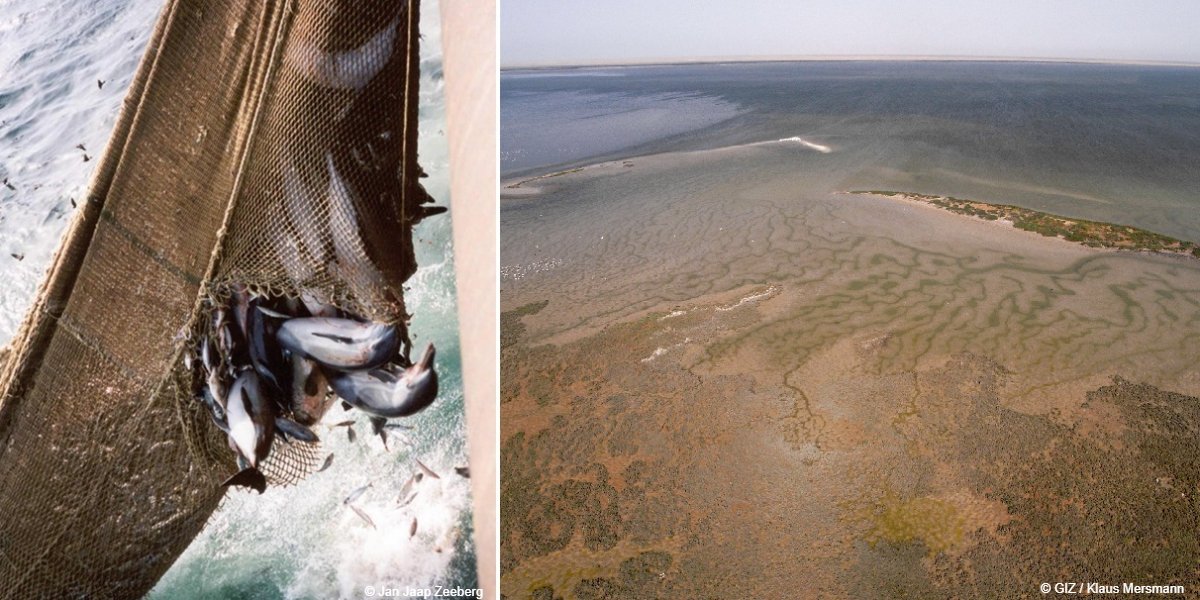
MeerWissen Webinar: West African Biodiversity under Pressure
The project “West African Biodiversity under Pressure” was introduced on February 26 as part of a webinar series featuring each of the 12 MeerWissen projects. The webinar provided both a comprehensive look at a variety of human-induced threats facing marine biodiversity off Mauritania and solutions that are being developed with key stakeholders in the region, such as a marine research strategy and an open source GIS. The recording and the presentation are available for download here.
The ocean along the Mauritanian coast is home to many vulnerable marine areas, like the famous Banc d’Arguin National Park, Africa’s largest Marine protected Area. This Wadden Sea like area is composed of intertidal mudflats and seagrass meadows forming the feeding grounds for very significant populations of wintering wader birds from the Palearctic and afro-tropical birds. Further offshore lies the continental slope, home to the largest cold-water coral barrier in the world and canyon systems acting as refuges for this rich benthic biodiversity. At the surface, clearly- defined pelagic hotspots appear thanks to a massive growth of plankton fertilized by nutrient rich upwelling water from the deep and energized by an intense tropical sun. This plankton attracts small pelagic fish, tuna, and quite significant portions of world populations of seabirds, dolphins and whales. These areas make offshore Mauritania one of the best-studied deep-sea areas in the world.
The biodiversity hotspots coincide with prime fishing zone of the international fleets (EU, China,Turkey, Mauritania) and an emerging Oil & Gas development. However, stocks of notably high-value table fish species thriving near the coast are crashing and pushing the artisanal fishing sector further at sea where they now exploit small pelagic fish species for a rapidly growing fishmeal industry. Fishing has caused direct impacts on these ecosystems leading to overfishing and regime shifts heading steadily towards jellification if no appropriate management actions to reverse the trend are taken.
The overall decline of higher trophic species exacerbates human induced climate change accelerating the deoxygenation and acidification of these waters. Furthermore, sea-level rise is setting large areas of this low-land coast under water. Horizontal and vertical shoaling of the oxygen minimum zone has already lead to a reduction of the pelagic habitat for high oxygen demanding species such as tuna and marlins and a regional extinction of sea star and sea-spiders in waters where the cold water corals live. A further deoxygenation will eventually extinguish the entire cold-water coral ecosystem and then mortify the pelagic communities via the formation of toxic hydrogen sulfide gasses, a phenomenon already noticed off the Namibian coast, the other upwelling eco-region of the continent.
However, knowledge gaps on coastal and marine ecosystem functioning and the genetic diversity remain. The open sea pelagic and benthic realms and also the coastal sea systems are so far, studied separately. While the connections are evident, they still need to be proven with empiric evidence. Only a small portion of species have been DNA barcoded, which is needed to predict changes in species populations more precisely. This is necessary to promote decision making towards taking corrective management measures. This would help to define the overall biodiversity status, their biological traits, and allow for surgical, but effective management. Today, the access to existing data is very limited for local stakeholders, the public and even science. No national marine GIS portal exists consolidating current insights into biodiversity and their drivers for change clear in an easy to understand format. The lack of knowledge transfer between different scientific disciplines is one reason why the ecological and biological aspects are so far excluded from the evaluation on fish resources virtually exclusively focused on commercial species (stock assessment, landing tonnage). Goodwill among policy makers and stakeholders gravitating around marine resource users to learn about new scientific insights is also needed.
Project partners of the WASP project are now developing a long-term marine research strategy and trying out ways to create more awareness about the urgency to protect slope biodiversity. In this context, face-to-face meetings with Ministers, regular dialogues with national authorities, private sector, civil society and Oil & Gas companies but also the press are organised. So far civil society (local NGOs, artisanal fishery federations), the press and Oil and Gas companies have been the most receptive to learn about new scientific insights and how this understanding also concerns them.
In further steps, DNA data will be gathered to establish a national barcode library. A user-friendly and open source GIS will be designed, including basic oceanographic data and further developed to achieve a comprehensive tool to investigate current and historic species distribution.
The main researchers involved in the project are:
- Prof. Dr. André Freiwald (Senckenberg Gesellschaft für Naturforschung)
- Sandra Kloff (Nature Mauritanie)
- Eli Beibou (Institut Mauritanien de Recherche Océanographique et des Pêches)